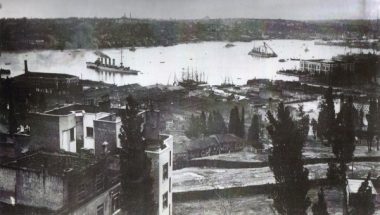
The Ottoman Empire officially entered the First World War as the consequence of a major naval operation, namely Yavuz and Midilli’s raid on Russian Black Sea ports in late October 1914. Although this first naval operation of the war was an offensive one, Turkish war efforts at the sea remained essentially defensive in character throughout the course of the war (though occasional sorties into Russian waters were undertaken) and they were almost exclusively restricted to the Black Sea and the Turkish Straits. Despite several technical and tactical problems, especially a chronic shortage of food, the fleet provided valuable assistance to the Turkish efforts at Gallipoli and the Caucasus.
Bosphorus and the Black Sea
After Yavuz and Midilli (formerly Goeben and Breslau) joined the Turkish fleet, commander of the German Mediterranean Squadron (Mittelmeerdivision der Kaiserlichen Marine), Admiral Wilhelm Souchon, was appointed the commander-in-chief of the Ottoman Navy as of August 18, 1914. Souchon immediately launched reforms in the navy and began with preparations for the approaching war. The Dardanelles were fortified, so was the Bosphorus and on September 27, 1914, the Turkish Straits were officially closed to all international shipping.
From the first day on, Souchon championed the idea of a Black Sea campaign against the Russians, which would serve Germany’s purpose of drawing Turkey into the war in order to open a new front. At the same time, Enver Paşa was discussing with Berlin proposals for Turkish intervention in the war, which included a fleet action to seize naval supremacy in the Black Sea without prior war declaration on Russia. Finally, on October 25, Enver Paşa gave a sealed order to Souchon, which explicitly called for “Black Sea maneuvers with the entire fleet and an attack on the Russian fleet if a suitable opportunity presented itself.” Simultaneously, the Minister of Navy, Cemal Paşa, ordered Turkish ship commanders to comply with the orders of Souchon under any circumstances.
Souchon's Black Sea raid
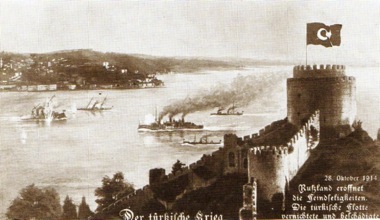 On October 27, battle-cruisers Yavuz and Midilli; cruisers Hamidiye, Berk-i Satvet and Peyk-i Şevket; destroyers Gayret-i Vataniye, Muavenet-i Milliye, Taşozand Samsun; and minelayers Nilüfer and Samsun assembled off the coast of Kilyos, north of Istanbul and set sail to the Black Sea. It was the first time after almost four decades that the Turkish fleet was entering the Black Sea on a mission. The operation was disguised as a drill, however during the same day, Souchon called a captains’ meeting aboard the Yavuz and unfolded the real plan of a series of closely coordinated attacks on Russian Black Sea ports, which deviated from Enver’s order of engaging the Russian fleet first. Accordingly, Yavuz would attack the Sevastopol port together with the destroyers Taşoz and Samsun and one minelayer; Midilli and Berk-i Satvetwould attack Novorossiysk and lay mines at the Kerch Strait; Hamidiye would attack Feodosia; Gayret-i Vataniye and Muavenet-i Milliye together with a minelayer would attack Odessa and lay mines off the coast of Ochakiv; whereas Peyk-i Şevket’s job was to cut the underwater communication cable between Varna and Sevastopol.
On October 27, battle-cruisers Yavuz and Midilli; cruisers Hamidiye, Berk-i Satvet and Peyk-i Şevket; destroyers Gayret-i Vataniye, Muavenet-i Milliye, Taşozand Samsun; and minelayers Nilüfer and Samsun assembled off the coast of Kilyos, north of Istanbul and set sail to the Black Sea. It was the first time after almost four decades that the Turkish fleet was entering the Black Sea on a mission. The operation was disguised as a drill, however during the same day, Souchon called a captains’ meeting aboard the Yavuz and unfolded the real plan of a series of closely coordinated attacks on Russian Black Sea ports, which deviated from Enver’s order of engaging the Russian fleet first. Accordingly, Yavuz would attack the Sevastopol port together with the destroyers Taşoz and Samsun and one minelayer; Midilli and Berk-i Satvetwould attack Novorossiysk and lay mines at the Kerch Strait; Hamidiye would attack Feodosia; Gayret-i Vataniye and Muavenet-i Milliye together with a minelayer would attack Odessa and lay mines off the coast of Ochakiv; whereas Peyk-i Şevket’s job was to cut the underwater communication cable between Varna and Sevastopol.
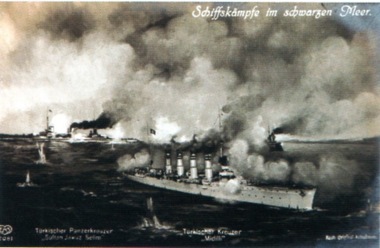 The first ships to arrive their destination were Gayret-i Vataniye and Muavenet-i Milliye, which entered the port of Odessa at 3:00 am on October 29. There was only minimal resistance by the Russians who were caught the surprise. A Russian gunboat, Donetsk, was sunk with a torpedo fired from Gayret-i Vataniye, another gunboat, Kubanets, was damaged by gunfire, the minelayer Beshtau was set on fire and four merchant ships were damaged. The two Turkish destroyers shelled the port for around one hour, destroying the power station and damaged the oil facilities. Meanwhile Samsun laid a total of 28 mines between Odessa and Sevastopol. All the three ships then returned safely to Istanbul.
The first ships to arrive their destination were Gayret-i Vataniye and Muavenet-i Milliye, which entered the port of Odessa at 3:00 am on October 29. There was only minimal resistance by the Russians who were caught the surprise. A Russian gunboat, Donetsk, was sunk with a torpedo fired from Gayret-i Vataniye, another gunboat, Kubanets, was damaged by gunfire, the minelayer Beshtau was set on fire and four merchant ships were damaged. The two Turkish destroyers shelled the port for around one hour, destroying the power station and damaged the oil facilities. Meanwhile Samsun laid a total of 28 mines between Odessa and Sevastopol. All the three ships then returned safely to Istanbul.
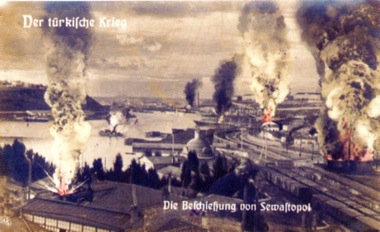 The main target of the Turkish fleet was the port of Sevastopol. At 5:00 am on October 29, Yavuz approached the port of Sevastopol behind the destroyers Taşoz and Samsun, after Nilüfer had dropped mines in the harbor approaches under the cover of the darkness. Yavuz fired a total of 59 rounds, however having been informed about the raid on Odessa, Russian commanders defending Sevastopol were well prepared and the Turkish fire was returned effectively by Russian coastal batteries. Yavuz received three hits and had to withdraw without achieving its target. On its way back, Yavuz met the Russian minelayer Prut accompanied by three torpedo boats led by Leitenant Pushkin. After a brief engagement, Prut was sunk and the Russian torpedo boats withdrew (according to Turkish sources Prut was loaded with 700 mines, whereas Russian sources state that there were 110 mines aboard). Later during the day Yavuz captured the Russian steamer Ida and Nilüfer managed to sink the steamer Velikii Kniaz Aleksandr. Meanwhile, the commander of the Russian Black Sea Fleet, Admiral Eberhardt, tried to bring Yavuz into battle with his pre-dreadnaught force, however after two days of cruising the latter headed back home.
The main target of the Turkish fleet was the port of Sevastopol. At 5:00 am on October 29, Yavuz approached the port of Sevastopol behind the destroyers Taşoz and Samsun, after Nilüfer had dropped mines in the harbor approaches under the cover of the darkness. Yavuz fired a total of 59 rounds, however having been informed about the raid on Odessa, Russian commanders defending Sevastopol were well prepared and the Turkish fire was returned effectively by Russian coastal batteries. Yavuz received three hits and had to withdraw without achieving its target. On its way back, Yavuz met the Russian minelayer Prut accompanied by three torpedo boats led by Leitenant Pushkin. After a brief engagement, Prut was sunk and the Russian torpedo boats withdrew (according to Turkish sources Prut was loaded with 700 mines, whereas Russian sources state that there were 110 mines aboard). Later during the day Yavuz captured the Russian steamer Ida and Nilüfer managed to sink the steamer Velikii Kniaz Aleksandr. Meanwhile, the commander of the Russian Black Sea Fleet, Admiral Eberhardt, tried to bring Yavuz into battle with his pre-dreadnaught force, however after two days of cruising the latter headed back home.
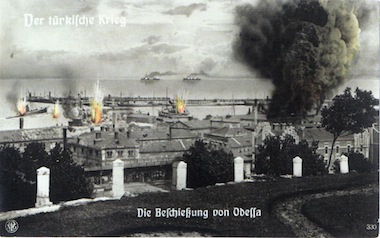 In the early hours of October 29, as Berk-i Satvet approached Novorossiysk, Midilli was establishing a 60-piece mine barrage in front of the Kerch Strait. At 10:00 am, Berk-i Satvet opened fire at the port installations and later Midilli arrived and joined in. The shelling went on for two hours, Midilli alone fired 300 rounds and the damage in Novorossiysk was considerably greater than what had been inflicted on other target ports. Meanwhile, the mines laid by Midilli sank two Russian steamers.
In the early hours of October 29, as Berk-i Satvet approached Novorossiysk, Midilli was establishing a 60-piece mine barrage in front of the Kerch Strait. At 10:00 am, Berk-i Satvet opened fire at the port installations and later Midilli arrived and joined in. The shelling went on for two hours, Midilli alone fired 300 rounds and the damage in Novorossiysk was considerably greater than what had been inflicted on other target ports. Meanwhile, the mines laid by Midilli sank two Russian steamers.
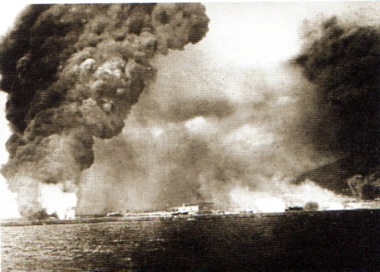
As Novorossiysk was under attack, another Turkish cruiser, Hamidiye was shelling the port of Feodosia. After this operation, Hamidiye cruised for a while along the Crimean coast, sinking the steamer Shura and the merchant ship Svyatov Nikolai on the way. On the other hand, the least successful among all the Turkish ships taking part in the Black Sea campaign was Peyk-i Şevket, which failed to cut the underwater communication cable between Varna and Sevastopol due to engine problems.
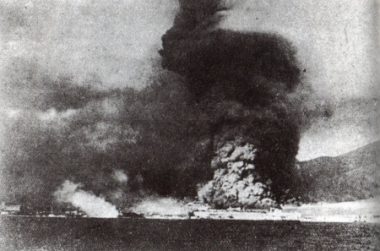
By the time Souchon had sailed to the Black Sea with his fleet, preparations were already completed to protect the Bosphorus from Russian attacks. Bosphorus Fortified Zone Command was responsible for the defense of the strait and in addition to the two battle cruisers (Barbaros Hayreddin and Turgut Reis) and four torpedo boats (Hamidabad, Sivrihisar, Sultanhisar and Demirhisar) patrolling the entrance of the Bosphorus, mines were laid and coastal batteries were strengthened.
Russian minefields
On November 2, 1914, Russia declared war on Turkey and two days later the Russian Black Sea Fleet (Chernomorskiy Flot) set sail towards Istanbul. The purpose of this first operation of the Russian fleet was to lay an offensive minefield off the Bosphorus and if possible to entice Yavuz into it. Four new destroyers, Gnevnyi, Derzkii, Bespokoynyi and Pronzitelnyi, laid the minefield and the following morning the old battleship Rostislav, together with the cruiser Kagul and six older destroyers bombarded the port of Zonguldak, the largest provider of coal supplies for the Turkish Navy. The Russians were hoping that Yavuz and the other Turkish warships would leave the Bosphorus and run into the newly laid minefield en route to Zonguldak they would. However, this did not happen, because, unbeknownst to the Russian commanders, Yavuz was already on the sea as Zonguldak was bombarded.
As the news from Zonguldak arrived, Yavuz and Berk-i Satvet were sailing towards Crimea. They immediately changed their direction to Ereğli on the Turkish Black Sea coast, in order to keep the Russian fleet busy so that they would be prevented from moving towards east where troop transportation to the Caucasus front was in progress. The Russian squadron, however, returned to Sevastopol, without encountering Yavuz. On the same day, November 7, Midilli shelled the port of Poti on the Caucasian coast.
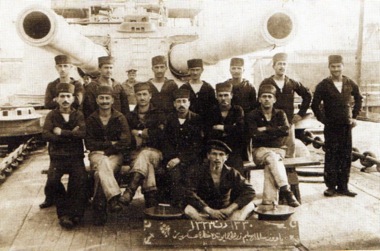
Turkish transports routes were indeed under threat. On December 6, three Turkish ships carrying supplies to the Caucasian front, Mithatpaşa, Bahr-i Ahmer and Bezm-i Alem, were sailing without escort when they encountered the Russian fleet that has bombed Zonguldak. All of them were sunk by the Russians, losing not only the valuable supplies including two aircrafts and an air battalion, but also 203 men, of whom 120 were taken prisoner by the Russians.
After Yavuz arrived back in Istanbul, Admiral Souchon submitted a report to the Ottoman High Command arguing that the first duty of the navy should be protecting the straits, keeping Bosphorus open and fighting with enemies who would attempt to prevent these. After these priority tasks came the protection of transportation routes from Zonguldak, Bulgaria and Romania. Since the Russian fleet was larger in terms of the number of vessels, the Turkish Navy should be actively involved in attacking Russian routes and coastal installations, which would force to the Russian to focus on self-defense rather than launching larger scaled offensive operations.
Meanwhile, the Russian commander, Admiral Eberhardt, was aware that his old ships were incapable of catching Yavuz or Midilli in an open sea chase and scattering the ships all along the coast was not the solution because that would only make the Russian ships easy prey for the Turkish fleet. Eberhardt’s strategy for protecting the Russian coast was then the elimination of Yavuz and for this she had to be drawn into battle under conditions determined by Russians. He began to design his plans accordingly.
On November 17, the Russian fleet shelled the port of Trabzon, a major supply base and transportation hub for the Turkish army fighting against the Russians on the Caucasian front, and returned home with the hope of drawing Yavuz, which was likely to chase them for retaliation, into a minefield.
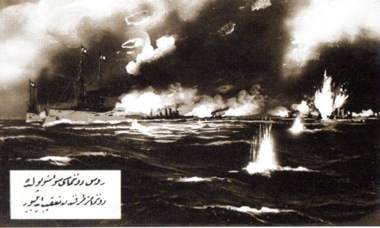
Yavuz and Midilli sortied from the Bosphorus and sailed to the Crimean waters. On November 18, around noon, they sighted the Russian fleet off the Cape of Sarych. Russian ships were in line ahead formation with Sv. Evstafi (Eberhardt’s flagship) leading, followed by Ioann Zlatoust, Panteleimon and the two older battleships Tri Sviatitelya and Rostislav. Midilli remained outside the effective fire range, as were the Russian destroyers and the battle took the shape a duel between Yavuz and Sv. Evstafi. There was fourteen minutes of gunfire exchange and then the action was over due to the thickening of the fog. Both ships received hits and were damaged badly, but managed to return home safely. Not so lucky was the Turkish minelayer Nilüfer, which, one day after this battle, hit a mine off the Bosphorus and was lost with 52 souls on board.
On November 20, Hamidiye shelled the port installations and oil tanks at Tuapse on the Caucasian coast, after which it embarked on a two-week operation, together with Midilli and Mecidiye, escorting transport ships carrying ammunition and other supplies to Trabzon. It was crucial to protect the supply lines against the Russians, however Souchon was pessimistic. He reported to the Ottoman High Command that the Caucasus campaign should not rely on sea transportation, of which the smooth functioning could only be a result of luck, given the threat posed by the Russian fleet.
On December 6, Yavuz accompanied by Berk-i Satvet, Peyk-i Şevket and Mecidiye set sail from Istanbul, escorting transport ships carrying troops and supplies for the Turkish army in the Caucasus. Enver Paşa was on board the Yavuz to see the situation himself. However, the main supply port, Trabzon, was found to be closed and therefore the convoy was diverted to Rize. Two weeks ago Russian minelayers Kseniya andKonstantin had established an offensive minefield off the eastern Anatolian coast, blocking not only Trabzon, but also Samsun, Ünye and Akçaabat.
After completing this escort mission, Yavuz and Peyk-i Şevket detached from the group, proceeded to Batumi and bombed the port there. The Russian fleet sailed to intercept, but they could not find the Turkish ships.
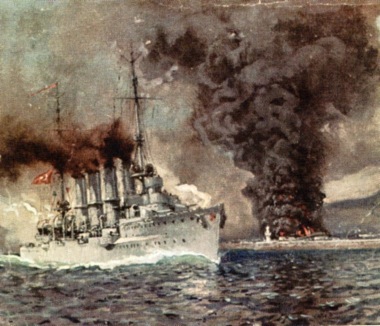
On December 20, Russian minelayers Kseniya, Aleksey, Georgyi and Konstantin departed from Sevastopol for Bosphorus. On the night of December 21/22, they established the second and third offensive minefields off Bosphorus. One of them had 370 mines and was blocking the Bosphorus-Sevastopol route, while the other had 320 mines and blocking the Zonguldak-Bosphorus route. Mines were laid in deep water, between 165-200 meters and since the Turkish mine sweeping equipment were inadequate; Turks could not provide sufficient protection against these mines. Turkish vessels worked very hard until February 1915 in order to ensure the safety of the Bosphorus and fortunately for them, the fact that the Russians did not undertake another mining operation for the next one and a half years prevented the situation from getting more complicated.
While the Russian minelayers were busy off the Bosphorus, Yavuz and Hamidiye were again escorting transports to the east. After completing this duty, Hamidiye shelled the Batumi port once again.
At this time, the Russians were launching another attempt to block the port of Zonguldak, this time by using block ships. On December 23, these block ships were joined by the battle force as Midilli was leaving the Bosphorus for its rendezvous with Yavuz off Sinop. Early the next morning Midilli encountered one of the Russian block ships and opened fire. Rostislav responded to Midilli’s fire, however it could not prevent three block ships from being scuttled in deep water during action. Midilli later changed its direction in order to escape a possible engagement with the larger Russian battle fleet.
On the next day at 4:30 pm, Midilli met with Yavuz and received the order to turn to east to patrol the Anatolian coast. Yavuz headed home, however on December 26, as it was entering the Bosphorus, it hit a Russian mine. The damage was severe; the ship took on over 600 tons of water, yet it survived, thanks to its sturdy construction. It was also lucky, because the damage occurred on both sides, preventing a strong list to one side. Yavuz managed to reach the docks and it was taken under repair.
At the Black Sea, the winter lull was a very short one, if there had been any. Russian mines were proving to be extremely effective and the year 1915 started with two Turkish ships hitting the mines, Berk-i Satvet on January 2 and the Burak Reis gunboat on January 10. The good news on the Turkish side was that Yavuz could set sail again although part of her damages was still unrepaired. She sailed on January 13, one day before the Russian Black Sea Fleet raided the Anatolian coast once again, sinking a steamer.
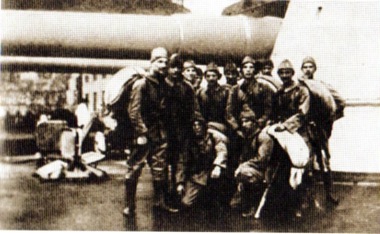
Meanwhile things were going downhill for the Turkish land troops on the Caucasian front. After the disaster of Sarıkamış, Enver Paşa, who was returning from the front to Istanbul sent a cable to the Navy command and asked for increased naval transportation of troops to this particular front where a renewed Russian offensive was imminent. Cemal Paşa, the Minister of Navy, was not sympathetic towards this idea. Not only was the danger of being intercepted on the way too high, but also a possible loss of Yavuz could not be tolerated. By the end of January 1915, the Ottoman High Command had given up the idea of transporting reinforcements to the Caucasian front through Black Sea routes.
On February 6, Midilli appeared off the coast of Batumi and opened fire on the Russian torpedo boats in the harbor. Meanwhile, the Russian fleet was patrolling the east Black Sea, and Midilli had to change its direction to Crimea in order to avoid an engagement. After sinking three small ships off Yalta, she returned to Istanbul. Russians responded by shelling the port of Trabzon on February 8.
This was a time when the Russian fleet was not only receiving newly commissioned large destroyers, but also the coastal defenses along the Russian Black Sea coastline were being strengthened. On March 1, the Russian fleet, which now included the new submarine Nerpa that went into action for the first time, bombarded the ports of Zonguldak and Ereğli.
Mecidiye lost
March 18, 1915 was the fateful day when the Allied attempts to force the Dardanelles had dramatically failed. On the same day, the Russian Black Sea fleet carried out its first diversionary bombardment of the Bosphorus, undertaken with the purpose of attracting the Turks’ attention away from the Dardanelles. Only one run was made and there was no significant response from the Turkish coastal batteries. The next day, operations discontinued due to the thick fog and the Russian fleet commander decided to attack the coal producing areas instead. Meanwhile, on the very same day, Midilli appeared off Feodosia and shelled the torpedo factory there and successfully escaped the pursuit of two Russian cruisers.
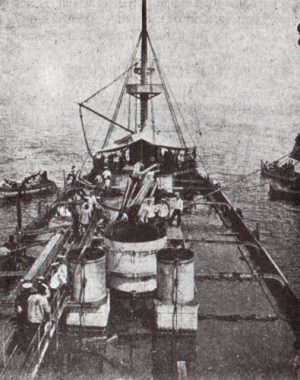
Admiral Souchon was planning a major response to the bombardment of Bosphorus. The target was Odessa and the attack would be carried out by the cruisers Mecidiye and Hamidiye, supported by destroyers Muavenet-i Milliye, Yadigar-ı Millet, Taşoz and Samsun, whereas Yavuz and Midilli would attack shipping off Sevastopol and cover the Odessa raid. This group departed from Istanbul and sighted Odessa in the early hours of April 3, 1915. But fortune was not on the Turks’ side and only 40 minutes after sighting the target, Mecidiye, which was under the command of Captain Ernst Büchsel, hit a mine. After two big explosions her forward boiler room flooded, she lost steering and settled on an even keel in shallow water with her upper deck awash. 26 men were killed on board and Hamidiye rescued the survivors, after which Yadigar-ı Millet torpedoed the derelict. The attempt to sink Mecidiye in order to prevent it from falling into Russian hands was, however, unsuccessful. The ship was salvaged by Russians in June 1915 and re-commissioned as Prut in October, named after the minelayer sunk by Yavuz earlier in the campaign.
As the bad news arrived to Admiral Souchon, who was on board Yavuz further south, the operation was aborted. After Yavuz and Midilli sunk one Russian merchant steamer each, the Turkish fleet headed back to Istanbul, and evading the torpedoes fired by Gnevnyi, it entered the Bosphorus early on the next day.
On April 15, the Russian fleet bombarded Zonguldak and Ereğli, followed by two diversionary bombardments of the Bosphorus, on April 25 and May 2 to 4. On May 9, the Russians shelled Ereğli and even managed to land a raiding party, which was repulsed soon after. A larger Russian offensive was imminent and therefore the Turks prepared its own fleet, which included the repaired Yavuz.
The Turkish destroyer Numune-i Hamiyet sighted the Russian fleet on the morning of May 10, and immediately cabled Yavuz that 12 enemy destroyers and minesweepers were approaching the Bosphorus. She also opened fire on the minesweepers, however had to retreat as the Russian destroyers returned fire. Yavuz was moving towards the Russians and she was sighted by Pamiat Merkuiriya on 06:45 am. Two older battleships came to the rescue of Pamiat and gunfire began to be exchanged as of 07:50 am, which went on for 22 minutes. Turkish sources state that Yavuz scored three hits and the Russians scored two, whereas Russian sources mention that Yavuz did not score any hits whereas the Russians scored four. The rest of the day was spent by maneuvering. Russians abandoned their plan to attack the Bosphorus and retreated.
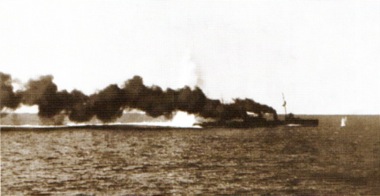
After this battle, the Russian fleet intensified its raids on the Turkish coastline with the objective of interrupting the coal supplies to Istanbul. Both Yavuz and Midilli played significant roles escorting the coal convoys sailing from Zonguldak and Ereğli to Istanbul. There has been a number of engagements between the Turkish and Russian fleets in this respect, including major battles like the one on June 10, between Midilli on one side, Gnevnyi and Derzkii on the other, and the one August 10 when Hamidiye and Yavuz engaged Tyulen. In another major engagement, on September 5, two Russian destroyers Bystryi and Pronzitelnyi supported by the submarine Nerpa intercepted a coal convoy from Zonguldak to Istanbul, escorted by cruiser Hamidiye and destroyers Numune-i Hamiyet and Muavenet-i Milliye. The two destroyers were outranged and soon Hamidiye found herself in a difficult situation, only to be rescued when Yavuz arrived for help.
German submarines
Two important developments during the latter half of 1915 had a significant impact on Turkish naval efforts in the Black Sea. First, German submarines arrived in Turkey. A total of 13 German submarines have been active in Turkish waters during the war and some of them have undertaken successful operations against the Russians in the Black Sea. The first sortie by a German submarine into the Black Sea was made by UB-7 on July 5, and this marked the beginning of a new phase of the war in the Black Sea. Second, on October 6, 1915, Bulgaria joined the Central Powers, the Bulgarian Navy was given under the command of Admiral Souchon as Varna became a base for Central Powers’ naval efforts in the Black Sea.
There were, however, favorable developments on the Russian side as well. In mid-July the first Russian dreadnought, Imperatritsa Maria, joined the Black Sea Fleet together with five new destroyers. She participated in her first operation on October 1, when the Russian Black Sea Fleet bombarded Kozlu, Zonguldak and Ereğli. Meanwhile the second Russian dreadnaught, Imperatritsa Ekaterina II, was completed and she became operational in December 1915.
The first and the only clash of dreadnaughts in the Black Sea took place on January 8, 1916, when Imperatritsa Ekaterina II opened fire on Yavuz off the coast of Zonguldak.The Russian ship’s fire was affected by defective turrets whereas on the other side Yavuz’s guns were outranged, so this clash was concluded without any damage on either side.
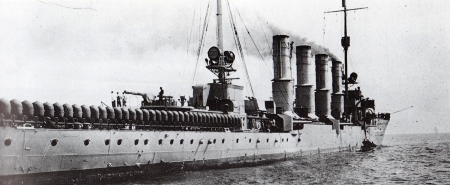
In early 1916, as the Russian land forces in the Caucasian front were commencing an offensive against the Turks and advancing towards Erzurum, the Russian Black Sea Fleet stepped up its raids on the Turkish coastline in Trabzon area, with the purpose of interdicting the flow of Turkish supplies and reinforcements by sea. At the same time Russian raids against coal convoys continued in the western part of the Black Sea.
After Erzurum fell on February 16, the Ottoman High Command ordered Midilli to carry a machine gun detachment, as well as airplane bombs and general ammunition to Trabzon. Midilli left Istanbul on February 27 and the next day she was informed that two Russian ships, Pronzitelnyi and Bespokoynyi were moving to the west after having bombed Giresun. Two sides encountered each other later that day, however Midilli refrained from an exchange of gunfire and retreated successfully.
On March 6, the Ottoman High Command asked the Navy to transport a regiment from Istanbul to Trabzon as fast as possible. The response was negative: "Yavuz is not able to carry a regiment, not even a battalion. Against a superior enemy fleet, it would not be able to disembark troops to Trabzon. Even if she had succeeded in this, the coal would be burned up too soon, due to the high speed required for such an operation, and it would not be possible to renew the coal from a source 500 miles away. Furthermore, if Yavuz and Midilli are lost, there would be no way to protect the grain and fuel imports from Romania and, even worse, the overall situation would deteriorate."
Despite this negative response, however, in the following weeks there have been instances when the risk was taken to have Midilli carry troops and ammunition to ports in the eastern Black Sea coast.
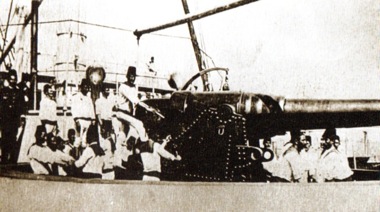
In one of such operations, on April 3, after having disembarked troops at Trabzon, Midilli sailed to Sürmene, 40 km east of Trabzon, shelled the Russian positions there and attacked the Russian minesweeper T233, which was eventually sunk by the German submarine U-33 accompanying Midilli. After this operation, Midilli sank a Russian sailing ship off Tuapse and early the next morning, she sighted Imperatritsa Maria. The Russian ship immediately opened fire and the firing went on for 15 minutes causing damage on Midilli, which commenced zigzagging. Midilli however managed to escape the fire without further damage and safely returned to Istanbul.
German submarines were coming to be increasingly used at Black Sea operations at this time. They were based in Istanbul and Evxinograd near Varna, and although their efforts against Russian warships were disappointing, they were more successful against merchant shipping and transports. One significant achievement of the submarines took place in early May, when they disturbed the Russian fleet that attempted to attack Varna. Three submarines were lost in the Black Sea during the year 1916. UB-7 left for Sevastopol on September 27 and never returned. A Russian officer who was taken prisoner the next year would claim that it was sunk by a hydroplane near Kerson. UB-45 hit a mine off the Varna coast on September 6 and sunk. UB-46 hit another mine off the entrance of Bosphorus on November 24 and went down. These losses brought the submarine casualty toll to four, including the UC-13, which had gone down due to bad weather on November 29 the previous year. Meanwhile UC-33 and UC-38 had left the Black Sea and returned to their bases in the Mediterranean. As the year 1916 ended, there were two German submarines left at the Black Sea, UB-14 and UB-42.

The port of Trabzon fell to the Russian land forces on April 18, 1916, which was a heavy blow for Turkish war efforts both on the land and at Black Sea. This capture came as the result of successful cooperation between Russian land forces and navy, which had already began to bear fruit when Russians captured Pazar and Çayeli on March 6 and landed two brigades in Rize on April 7. Amphibious operations continued after Trabzon fell. Troops landed at Kovata, ten km east to Trabzon, on May 7 and at Terme on November 2.
Russia spiraling down
Black Sea operations were now directly linked to the war on the land. From May 1916 onwards, both sides intensified their mine-laying and minesweeping operations in various parts of the Black Sea. Yavuz could not be very active in this period, because it was still undergoing reparations. The only significant action of hers took place on July 4, when it attacked Tuapse and Lazarevskoje, simultaneously with Midilli’s attack on Sochi. It was to be the last operation of Yavuz in the Black Sea during the World War. These attacks delivered substantial psychological pressure on the Russians and led to the dismissal of Admiral Eberhardt, who was replaced by Admiral Kolchak as the commander of the Black Sea Fleet.
On July 21, Midilli set sail again on a mine-laying mission with 65 mines to be laid off Novorossiisk. The next day, as she was around 100 miles north of Sinop, she spotted four Russian vessels cruising on the Sevastopol-Trabzon route. The first ship to engage Midilli was the Shchastlivyi, which retreated after Midilli returned fire, drawing her close to Imperatritsa Maria. The dreadnaught opened fire and Midilli could escape only by laying a smoke screen around herself. The engagement went on for the whole day and Midilli suffered damages, however managing to return safely back to Istanbul. The Russian destroyers that were ordered to chase Midilli could not do so because of heavy rain.
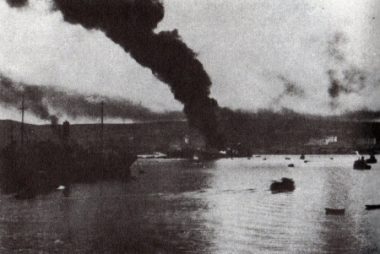
Russians received a heavy blow on October 20, 1916, when Imperatritsa Maria, anchored at the port of Sevastopol had a series of explosions and had to be flooded. The reason of these fatal explosions still remains a unknown and whereas a sabotage could be possible the most common explanation today is that it was a case of self-ignition of the cordite. This was immediately followed by a loss on the Turkish side. The destroyer Gayret-i Vataniye ran on uncharted rocks off the Bulgarian coast on October 28 and had to be abandoned.
Romania’s entry into the war shifted the focus of the war in this theatre to the western part of the Black Sea. German aircraft and submarines began to concentrate their efforts on interrupting the Russian sea traffic to Romania and several sorties were made on the port of Constanta to this end. Midilli joined these efforts by laying mines off the Danube.
The year 1917 saw the continuation of action in all areas of the Black Sea, albeit at a decreasing rate. The revolution in Russia was felt in the Black Sea Fleet but it did not change the course of events and hostilities continued until the armistice was signed. Russian ships continued to raid the Turkish coasts and Russian commanders began to press harder on a possible Bosphorus landing in order to save the war efforts of the Entente in this theatre. However these landings never took place, because the effects of the revolution were weakening the Russian fleet. Supplies were not coming anymore and discipline was cracking.
Midilli entered the Black Sea on June 24, 1917, and laid 70 mines in the Danube delta, after which she landed a small landing party on Fidonisi Island where a Russian wireless station was destroyed and 11 prisoners were taken. The next day, a group of Russian warships that were on a mine-laying mission sighted Midilli (and the accompanying Basra). Imperatritsa Ekaterina II (renamed as Svobodnaya Rossiya after the revolution) opened fire on her, however Midilli managed to remain outside the firing range and made it safely back to Istanbul.
The Turkish side lost two ships during the second half of the year. On July 10, Yadigar-ı Millet was bombed by British aircraft as it was anchored in Istanbul. Yavuz and Midilli, which were also at the port then, survived this aerial attack unharmed. On October 29, torpedo boat Hamidabad was attacked by two Russian destroyers and sunk as it was escorting a mine laying operation near İğneada.
After the loss of Hamidabad, Midilli undertook a series of enemy finding missions in the Black Sea during the first few weeks of November 1917.These were the last operations of the war at the Black Sea. By the end of 1917, the Russian Black Sea Fleet ceased to exist as a fighting force, and after that the task of the Turkish Navy was to oversee the disarming process of the Russian fleet, to clean the Bosphorus area from enemy mines and to ensure safe navigation. This task was completed by October 1918.
The Dardanelles
In the summer of 1914, as the clock was ticking down to war in Europe, the Dardanelles were only weakly defended. Mines that were laid during the Balkan War had been removed during the earlier months of the year and there were only a handful coastal batteries at the entrance and in the middle part of the straits. After the war broke out, the Ottoman High Command ordered the partial closure of the Dardanelles as a part of the mobilisation. Mines began to be laid by Samsun, Selanik and İntibah and coastal batteries began to be strengthened against possible Allied attempts to cross the straits.
These measures were not deemed enough in the face of an Allied fleet that was already patrolling off the Dardanelles since early August. The Ottoman High Command and the German Military Mission decided to use an old warship as a floating battery inside the Dardanelles. The task was given to the battleship Mesudiye, which was in service since 1874, and on September 16, 1914, under the command of Maj. Beşiktaşlı Arif Bey (who would later be replaced by Fazıl Bey), Mesudiye arrived in the Dardanelles and anchored at Sarısığlar Bay off the Nara Point on the Asian shore. Later on, most of the guns of Mesudiye would be dismantled to be used at coastal batteries but the ship would stay where it was.
On November 2, 1914, a few days after Yavuz and Midilli bombed the Russian Black Sea ports, bringing the Ottoman Empire officially into the war, the Allied fleet opened hostilities. The first casualty was the gunboat Burak Reis, which was sunk off İzmir. The next day, action began at the Dardanelles. Two British cruisers, Indefatigable and Indomitable bombarded Seddülbahir (where the munition storage received a direct hit) and Ertuğrul batteries on the European shore, whereas the French Suffren and Verite shelled the batteries on the Asian shore.
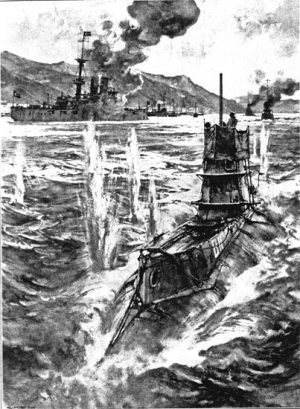
The Allies were planning first to cross the straits with submarines, which would make the warships’ job easier in the subsequent phases of the war. However, crossing the straits was not an easy job, not only because of the mine barrages, coastal barriers, observers and projectors, but also because of the strong currents and differences in water density. The first Allied submarine to be sighted by the Turks was the French Faradi, which, on November 23, approached the entrance of the Dardanelles, but had to retreat as the Turkish batteries at Seddülbahir opened fire. A few days later, the British submarine B-11, commanded by Lt Cmd Norman Holbrook was given the task to attempt to force the Dardanelles.
B-11 set sail from Tenedos during the early hours of December 13, 1914. Successfully passing under five mine barrages, she arrived at the Sarısığlar Bay where she sighted Mesudiye at around 11:30 am. B-11 fired two torpedoes. Mesudiye immediately opened fire with her remaining guns, but this was to no avail. In ten minutes the battleship capsized and sank in shallow water: "There was no point in continuing to fire. I had to think about the personnel, so I ordered ceasefire to be followed by an order to leave the ship. The first torpedo of the enemy submarine hit a little above the ammunition storage of Mesudiye’s stern guns. If it were only 15-20 cm below, it would be a direct hit on the ammunition storage and the ship would blow up in the instant. We had replaced the removed guns with sand and chains in order to keep the balance. If that had not been done, the ammunition storage would be elevated and that would result in a direct hit." (Captain Üsküdarlı Rıfat Bey, who was the acting commander of Mesudiye at the time of the attack, in his memoirs)
As B-11 returned to its base, the Turkish transport Bolayır rescued 48 officers and 573 men from Mesudiye. Some sailors were trapped inside the ship and it took 36 hours to release them. Total Turkish losses were 34, including ten officers and 24 men. The guns salvaged from Mesudiyewere installed at a coastal battery named after the ship itself.
The loss of Mesudiye was a psychological blow for the Turks, which forced them to strengthen the defenses of the Dardanelles. New mine barrages were erected by Samsun and Nusrat. By the end of 1914, there were nine lines comprising of a total of 324 mines inside the Dardanelles. On the Allied side, encouraged by B-11’s success, Vice Admiral Sackville Carden asked for more submarines to be deployed in the area, although his request could only be fulfilled to a limited extent by the Admiralty. Carden also decreed that no Allied submarine would sail on patrol without his express permission.
In an attempt to replicate the success of B-11, the French submarine Saphir left its base during the early hours of January 15, 1915 and attempted to break through to the Sea of Marmara, without Carden’s permission. It managed to pass under the mine barrages, however as it surfaced off the Nara Point, close to the location where Mesudiye was sunk, it came face to face with the Turkish gunboat İsa Reis and minelayer Nusrat. Turkish ships opened fire on Saphir, which was badly damaged. The submarine hit the bottom first, then surfaced and sunk again. 14 French sailors were dead and 13 survivors were rescued from the sea by Nusrat.
At the same time when Saphir was making its final voyage, the War Council in London was debating the plan for the upcoming Allied attack to force the Dardanelles and open the way to the Sea of Marmara and eventually to Istanbul. The first phase of the plan was implemented on February 19 when six Allied warships opened fire on the forts at the entrance of the Dardanelles, though without much success. Six days later the Allied fleet stroke back and although at the end of the day it had to retreat after facing a serious counterattack, it still managed to destroy some Turkish guns.
March 1915 started with small-scaled attacks of the Allied fleet. Almost every day one or two battleships entered the Dardanelles, shelled the Turkish batteries and retreated. Mine sweeping efforts of the Allied fleet did not prove to be successful due to Turkish artillery fire.
A minelayer writing history
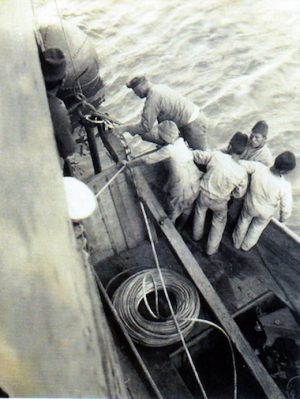
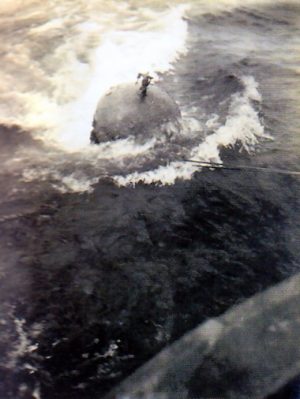
March 18, 1915 was the day when the Allies embarked on a disastrous attempt to cross the Dardanelles and, having failed to achive their objective and suffering severe losses, had to completely change their war plans. On that day, the combined Allied fleet, now under the command of Admiral de Robeck, tried to force the straits. However, this renewed attack by sixteen Allied battleships plus many other smaller vessels turned out to be a dramatic failure, mainly due to the unsuspected drifting mines laid by the Turkish minelayer Nusrat, commanded by Maj. Tophaneli Hakkı Bey. The mines were laid there ten days ago. The diary entry of Maj. Nazmi Bey, Nusrat’s mining officer, for March 8, 1915, was as follows: “Upon the order received, at 05:30 in the morning Nusrat established a line of 26 carbonic mines between Paleokastro and Erenköy coast and safely returned home. No enemy was sighted. Mines are laid at a depth of 4.5 meters with intervals of 100-150 meters. There has been light bombardment from enemy fortifications.”
Nusrat had changed the course of the war. Five Allied warships were sunk or disabled by mines on March 18. These were the British Inflexible, Irresistible and Ocean; and the French Bouvet and Gaulois. Furthermore, the Allies lost two destroyers and seven mine sweepers. Their total human loss was 1,273 dead and 647 wounded against a Turkish casualty toll of 124 dead. After this failure, the Allies gave up the idea of forcing the Dardanelles only with naval force. (Read more on the events of 18 March 1915 in the Gallipoli section).
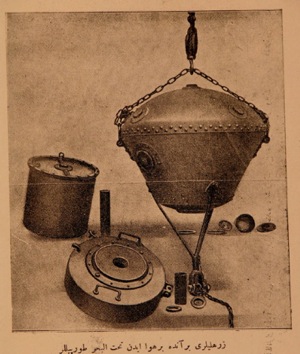
Another Allied attempt to break through from beneath the sea came on April 17, this time by the British submarine E-15. She was caught by strong currents and forced to surface as she was right off the Dardanos batteries. Turkish guns immediately opened fire as the submarine was driven on to the sand banks. The commander of the submarine and six sailors were killed and the rest of the crew was taken prisoner. In the afternoon on the same day the Turks began with the salvage, however the next night a steamboat from the Majestic approached the grounded E-15 and managed to torpedo it in order to prevent the salvage.
April 25, 1915 was the first day of Allied landings. British forces landed at the tip of the peninsula, Anzacs further north and the French on the Asian shore. The day was marked by a strong resistance by the Turks, unexpected by the Allied commanders. This resistance was supported by Turkish warships Turgut Reis and Barbaros Hayreddin that shelled the British landings. These two ships had been stationed at the Dardanelles for the last two months.
The Australian submarine
What was unexpected for the Turks was, however, that as the Allied troops were landing on the shores of Gallipoli, an Australian submarine, AE-2, was making its way through the straits. Commanded by Lt Cmd. H.G. Stoker, the AE-2 left its port at Tenedos and entered the straits at 02:30 am on April 25. She was detected by Turkish batteries, however she could evade them by submerging. Sailing through strong currents and beneath mine barrages and with mine wires scraping her body several times, AE-2 managed to pass through and around 06:00 am, as she rose to periscope depth, she found itself off the city of Çanakkale. She could not stay surfaced for a long time, due to Turkish gunfire and tracking warships, and had to submerge again. She was grounded twice, but each time Stoker could keep his submarine going. Early the next morning, AE2 sighted Turgut Reis, she fired two torpedoes, but they passed ahead of the Turkish warship. About 07:00 am on April 26 she passed the town of Gelibolu and entered the Sea of Marmara. The Australian submarine thus became the first Allied submarine to pass through the Dardanelles and reach the waters of the Sea of Marmara during the World War.
That day as Stoker was trying to figure out how to get the message on AE-2’s success to the Allied headquarters and what to do next, the submarine encountered Barbaros Hayreddin, fired a torpedo, but missed the warship. The next day, AE-2 sighted a transport that was escorted by the torpedo boat Sultanhisar. It was yet another miss for the submarine, which had to escape from Sultanhisar’s attack by diving away. On April 28, this time a four-ship convoy escorted by Muavenet-i Milliye was sighted, a torpedo was fired, but it went wide.
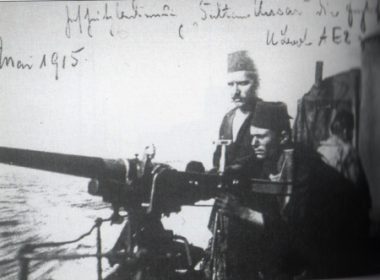
At this time, Sultanhisar, commanded by Captain Ali Rıza Bey, was fastidiously looking for the AE-2 around the area between Maydos and Çanakkale when it was ordered to return to Istanbul for replacement by another torpedo boat, Basra. At around 08:00 am on April 30, as she was off the Marmara Island on her way back to Istanbul, the tide turned for Sultanhisar. The submarine she was looking for was right there. Sultanhisarimmediately opened fire on AE-2’s periscope. At this point, Stoker and Ali Rıza’s accounts differ from each other. Stoker argued that he did not fire any torpedoes, whereas Ali Rıza wrote that he evaded AE-2’s torpedo. Meanwhile, Sultanhisar, which had two torpedoes, fired both of them. The first failed to ignite and fell overboard, whereas the second was a miss.
AE-2 was damaged and could not submerge. On the other side, Sultanhisar was out of torpedoes and its guns were ineffective. Ali Rıza Bey’s decision was to collide with the submarine for a final blow, no matter how risky it was: "Collision… When this crossed my mind, I looked at my ship first and then at the opposing vessel. Next to this 800 something tons vessel, mine was looking like a small boat. Could the power of 93-ton Sultanhisar’s weak body open a wound on this giant? I stopped thinking about this. I had to resort to the last option I had, at any cost. Leaving the battlefield could be another option, but this was out of question… Maybe we would not be victorious. Maybe both Sultanhisar and AE-2 would be destroyed as a result of the collision and go down the blue waters of the Marmara. But we would collide anyway… This was the only option, the only option that could take us to death, but also to victory" (Ali Rıza Bey in his memoirs).
Sultanhisar began to move at full speed towards the AE-2, but just as she was about to hit, Ali Rıza Bey turned sharply away and aborted the attack. AE-2 was now completely surfaced, with a white flag hoisted on its tower and the sailors were leaving the damaged submarine. Sultanhisar picked up AE-2’s crew of three officers and 29 men, soon after which the submarine sank to the bottom.
One day before it was sunk, AE-2 had a chance meeting with the British submarine E-14 at the Sea of Marmara. E-14, commanded by Lt Cmd E.C. Boyle, had broken through the straits two days after the AE-2 did. She survived the gunfire of Aydın Reis and torpedo boat Yunus, and attacked the warship Muavenet-i Milliye, albeit without success.
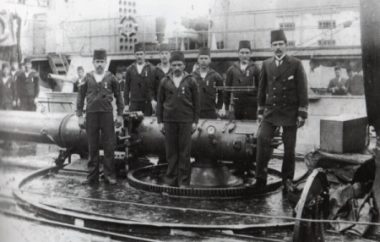
E-14 remained in the Sea of Marmara and on May 10, she sighted the transports Patmos and Gülcemal, which were carrying troops from Istanbul to Çanakkale under the escort of the destroyer Gayret-i Vataniye, which was commanded by Kasımpaşalı Cemil Ali Bey. The torpedo shot at Patmos was a miss, but the one fired on Gülcemal hit the transport’s bow and caused the damage. Gülcemal, however, did not sink, at the troops and materials on board were salvaged by two ferries arriving at the scene, and the ship itself was taken in tow to Istanbul. After this incident, E-14 cruised the Sea of Marmara for some time without any torpedoes left and therefore being unable to attack Turkish ships, before returning to her base at Tenedos on May 19.
Meanwhile, in those early periods of the Allied land offensive, two British warships were sailing into the Morto Bay off Cape Helles every evening, opening fire on Turkish positions with the purpose of relieving the pressure on the French units in this sector. These ships were inflicting heavy casualties and the Turkish Fifth Army asked the General Inspectorate of the Straits for assistance in this matter. First, the intention was to send three Draç-class torpedo boats to the area, however since they had only one torpedo each and there was not enough maneuvering area at the bay for three vessels, it was decided to assign this duty to the destroyer Muavenet-i Milliye, which had recently taken over the task of submarine patrolling in the Sea of Marmara from Numune-i Hamiyet.
Commanded by Captain Ahmet Saffet Bey and with German Captain Rudolph Firle as liaison officer, Muavenet-i Milliye arrived in Çanakkale on May 10 and after the necessary preparations she set sail in the evening of May 12, anchoring off Soğanlıdere where she waited for the nightfall. At that night, British warships Goliath and Cornwallis were stationed at Morto Bay, screened by five destroyers. Muavenet-i Milliyeraised anchor after midnight, skipped through the European side of the straits undetected by destroyers and sighted Goliath at 01:15 am: "We were approaching the ship. They must have spotted us, so they began to make some signs. Considering the possibility that this was a request for password, I went up to the bridge and began to respond to the signs with a hand lamp. But what signs! Some lines and points without any meaning whatsoever… Our intention was to gain time by forcing the enemy into hesitation and to get closer to it… We could not afford to lose more time. Our identity was fully revealed because of the flames coming out of our funnels after the engines were switched to full speed. We were 400-500 m to the enemy and we came even closer, 300 m, in order to launch the attack" (The torpedo officer of Muavenet-i Milliye, Ali Haydar Bey, in his memoirs).
Muavenet-i Milliye fired three torpedoes. The first torpedo hit Goliath’s bridge, the second hit the funnel, and the third her stern. Goliath capsized immediately, taking 570 of the 750-strong crew to the bottom, including the captain T.L. Shelford. Cornwallis was left untouched, because Muavenet-i Milliye used all of its torpedoes on Goliath in order to ensure the sinking of at least one warship instead of dividing its torpedoes and risking both.
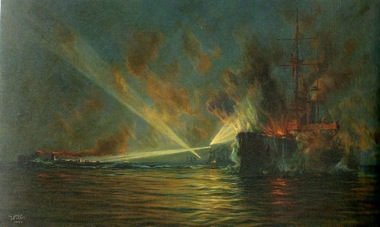
The success of Muavenet-i Milliye was a great morale boost for the Turkish defenders at Gallipoli and it had proven to the Allies that it was impossible to open the straits by a naval attack. However, Allied submarine operations were continuing with great enthusiasm. On May 19, 1915, the British submarine E-11, the “most diabolic of all submarines entering the Marmara” (in the words of Nejat Gülen), launched its first operation through the Dardanelles and approached the capital of the Ottoman Empire. On May 23, she was near the gunpowder factory at Bakırköy, a suburb of Istanbul, which was protected by the gunboat Peleng-i Derya anchored at the shore. E-11 caught the gunboat by surprise and torpedoed it. Peleng-i Derya capsized, with two sailors losing their lives, but as she was going down the gunboat managed to damage E-11’s conning tower. The next day, E-11 stopped the transport Nara off Kocaburun, ordered her crew to abandon the ship and sunk her together with her valuable cargo of gun barrels and mountings. E-11 then made it to Rodosto and sunk the ferry Hünkar İskelesi at the pier.
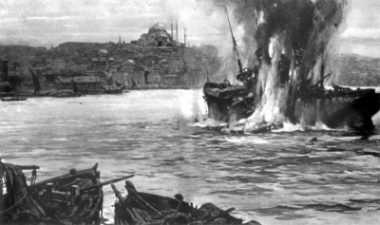
On May 25, E-11, commanded by Lt Cmd Martin Nasmith, reached Istanbul and spotted a total of 14 transports assembled at Galata and Sirkeci piers, which were being prepared to carry the Turkish 1st Army Division to Gallipoli. E-11 fired two torpedoes, one of which exploded on the pier and the other wrecked a barge that was standing in front of the transport İstanbul, which was only slightly damaged. Although the physical damage caused by E-11 was insignificant, its psychological effect was greater. The enemy was right in the heart of Istanbul and this unexpected event led to a panic among the civilian population. Furthermore, troop embarkation on ships had to be halted. It was decided to send the army division to the front overland.
E-11 remained in the waters around Bosphorus until June 7 and menaced the Turkish sea traffic in the Sea of Marmara. During this first tour of hers, she sank or disabled a total of eleven ships.
Otto Hersing's U-21
Now, let us turn back to the early hours of that fateful day of April 25. As Allied troops were landing on Gallipoli and AE-2 was making her way through the Dardanelles, another submarine, the German U-21 commanded by Lt Cmd Otto Hersing was leaving the German North Sea submarine base at Wilhelmshaven. She was ordered to sail to the Dardanelles to support the Turkish war efforts there. The voyage took one month, and as of the early hours May 25, 1915, she approached the Gallipoli peninsula. Around noon that day, U-21 sighted the British warship Triumph off Kabatepe. Having her torpedo nets out, guns manned and a large destroyer screening her, she was firing on Turkish positions that were countering the Anzacs: "I decided to attack. At that depth the destroyer could not ram me. There was no time to go further deep and since I was moving towards Triumph. I had to fire the torpedo immediately in order to avoid collision… I was 16 meters deep and the propellers of the destroyer were turning above me… Seconds were like water drops slowly falling on the ground. Nothing was happening… The sound of the propellers faded away and the bomb that would destroy the submarine did not fall. The destroyer had not recognized us! As I looked through the periscope, the battleship was 400 meters ahead. I had deviated from the target and I had to make a sharp turn. Full speed ahead. 300 meters… 200 meters… And I fired the torpedo! Right through the torpedo net!" (Otto Hersing in his memoirs).
There was a big explosion on Triumph, and the ship began to list to starboard. After 15 minutes she capsized, remained afloat upside down for half an hour and began to sink. Three officers and 75 sailors died on board the Triumph, whereas the survivors were salvaged by the destroyer accompanying the warship.
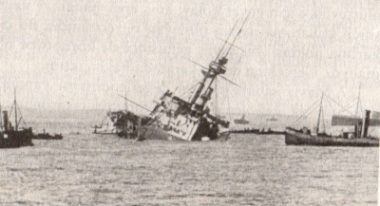 Another Allied warship that was bombarding the Turkish positions was the Majestic. On May 27, that is two days after Triumph was sunk, she was stationed off Teke Bay (W Beach), behind a protective screen composed of destroyers and torpedo nets. Unfortunately for the Majestic, Hersing’s U-21 was there looking for a weak point of the protective screen. The German captain wrote: “As I was moving along this bee hive, finally I spotted a hole. This hole was not too big, at most 20 meters. However I had to try. I directed my submarine towards the target. Who knows, maybe… Now I had turned the submarine to point to Majestic’s stern. I pushed the electrical button… The submarine was shaken, the torpedo was fired…”
Another Allied warship that was bombarding the Turkish positions was the Majestic. On May 27, that is two days after Triumph was sunk, she was stationed off Teke Bay (W Beach), behind a protective screen composed of destroyers and torpedo nets. Unfortunately for the Majestic, Hersing’s U-21 was there looking for a weak point of the protective screen. The German captain wrote: “As I was moving along this bee hive, finally I spotted a hole. This hole was not too big, at most 20 meters. However I had to try. I directed my submarine towards the target. Who knows, maybe… Now I had turned the submarine to point to Majestic’s stern. I pushed the electrical button… The submarine was shaken, the torpedo was fired…”
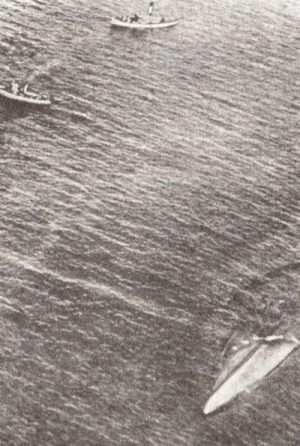
That single torpedo spelled the end of the 15,000-ton warship. She began to list to port and capsized in 16 meters of water, killing 49 men. Her upturned hull remained visible for many months until finally submerging during a storm on the night of November 17, 1915.
British submarines continued their sorties to the Sea of Marmara during the summer of 1915. E-14 carried out its second cruise between June 10 and July 3, E-12 had its first cruise between June 19-28, and E-7 had its first cruise between June 30 and July 24. E-7, commanded by Lt Cmd Cochrane, even made it to Istanbul, but having found the Galata pier empty, she shelled a few munitions factories and railway lines without causing much damage.
Meanwhile, the Turkish were busy with strengthening their defenses against enemy submarines. By the end of July, the new submarine nets made of steel were ready. These nets were spanning all the way down from the surface, where they were fixed with net buoys, to the bottom. The only place where they could be passed through was the shallow waters of Nara and it was observed by gunboats and coastal batteries.
Nasmith’s E-11, newly refitted with a deck gun, launched its second sortie on August 5. The new steel nets came as a surprise for Nasmith, but E-11 was lucky, she benefited from the damage caused by strong currents on the net and made her way through it. At around 07:00 am that morning, she sank the Turkish transport Halep off the Akbaş port, and later during the day she spotted Aydın Reis, which was carrying Admiral von Usedom’s staff from Istanbul. Aydın Reis opened fire immediately and intended to ram the submarine; E-11 escaped by diving away.
The next day, E-11 met with E-14 for joint operations and their first victim was the torpedo cruiser Peyk-i Şevket, which was torpedoed and had to be grounded. The Turks managed to salvage the cruiser two days later, however it was a big disappointment for them that the new steel nets had failed to stop the enemy submarines. Gayret-i Vataniye, Yadigar-ı Millet, Yarhisar and Basra were ordered to patrol the waters around the location where Peyk-i Şevket was attacked and to find the enemy submarines.
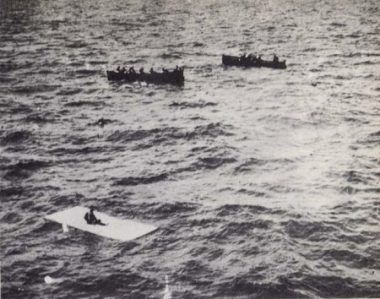
As these efforts were underway at the northern entrance of the Dardanelles, additional British forces were landing at Suvla Bay and the Turkish troops countering them were in urgent need for naval support fire. Admiral Souchon gave this task to Barbaros Hayreddin, which was then anchored at Istanbul. The warship left Istanbul on August 7 with only one escort, the torpedo boat Sivrihisar. The next morning, as Barbaros Hayreddin was sighted by E-11 off Bolayır. It was a windy day and the sea was foamy, making it impossible for Barbaros Hayreddin to see the enemy’s periscope. E-11 fired a torpedo, hit Barbaros Hayreddin, which capsized, floated bottom-up for a few minutes and went down. There were more than 700 men on board the warship. 21 officers and 237 men lost their lives, and the rest were rescued by Sivrihisar and Basra.
Three days later Sivrihisar found E-11 and opened fire on her, but the submarine managed to escape by diving away. She would remain in the Sea of Marmara until September 3, having sunk one Turkish warship, one torpedo boat, six transports and 23 sailing ships within 29 days. After E-11 returned to the base, E-7 departed for its second sortie into the Sea of Marmara. This time the steel nets worked. E-7 became entangled in the nets at a depth of 35 meters and the Turkish boats noticed that the net buoys were being dragged under water. Lt Cmd Cochrane’s efforts to free the submarine were useless and to make things worse for him, the German submarine UB-14 commanded by Lt Cmd Hugo von Heimburg arrived in the scene and dropped explosives. E-7 had no option left but to surface and surrender. Her crew of 28 men was taken prisoner and the submarine was scuttled.
Another British submarine, E-2, launched two sorties into the Sea of Marmara, one between August 13 - September 14 and the other between December 9 and January 2. In her first cruise, it sank the minelayer Samsun on August 14. Other than that, the casualties caused by E-2 were minor. Sorties of E-12 between September 16 - October 24 and of H-1 between October 2-31 produced similar results.
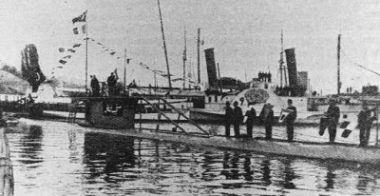
The only French submarine to enter the Sea of Marmara was Turquoise. She did so on October 20, met with E-20 as planned, but, having made little contact with Turkish vessels, she decided to return to her base. As Turquoiseapproached the nets off Akbaş, she was spotted by Turkish batteries, which immediately opened fire on the submarine. While maneuvering, Turquoise hit the bottom, surfaced and was hit again. The French sailors abandoned the submarine and they were taken prisoner. Turquoise was easily salvaged by the Turks and towed to Istanbul. On November 10, the submarine was transferred to the Ottoman Navy, named Müstecip Onbaşı after the artillery corporal who first shot the submarine on October 30.
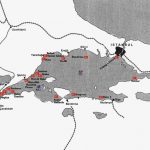
One benefit from the capture of the French submarine was that there were secret documents about the meeting points of Allied submarines, their passwords and signs. Soon it was found out that the only submarine still operating in the Sea of Marmara was the E-20. Eventually, Von Heimburg’s UB-14 caught her by surprise at a meeting point and fired a torpedo. E-20 sunk in a few minutes and its crew was salvaged from the sea by UB-14.
This was one of the last naval actions of the war at the Dardanelles. In December 1915, the Allies began to leave the peninsula and the evacuation was completed as of January 9, 1916. After hostilities ended on the peninsula and the waters around it, what went on in this area was limited to changes in mine barrages and coastal fortifications as well as occasional engagements with enemy vessels that remained in the North Aegean waiting for Yavuz or Midilli to make a sortie, and bombing of islands held by Allies.
The end of the war
In September 1917, as naval action at the Black Sea was over as well, the new commander of the Turkish Fleet, Admiral Hubert von Rebeur-Paschwitz devised a plan an offensive against the enemy units in the North Aegean. At this time the Ottoman High Command was asking for a German submarine operation against Allied troops that would leave the Macedonian front and sent to Palestine as reinforcements. Berlin rejected this demand, but Admiral von Rebeur-Paschwitz saw here a good opportunity to materialize his plan. Instead of German submarines, he would intercept the Allied transports with Yavuz and Midilli.
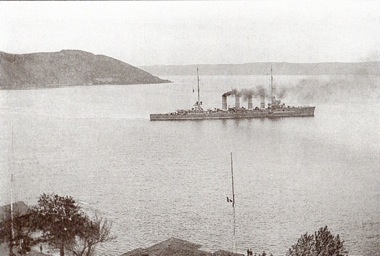
In the early hours of January 20, 1918, Yavuz and Midilli safely left the straits and reached a position off Seddülbahir (Cape Helles). At 06:10 am, Yavuz hit a mine, but the damage was insignificant and she sailed on to shell the radio station at Kephalo. Meanwhile Midilli proceeded towards Imbros. At 07:45 am Yavuz and Midilli together opened fire on two British monitors, M-28 andReglan, and sunk them.
Around half an hour later, two British destroyers, Lizard and Tigress, and British airplanes were sighted. The first few bombs fell close to Yavuz, and shortly afterwards Midilli hit a mine. The two Turkish warships had run into an enemy minefield. Yavuz hit a mine, and within half an hour Midilli was struck by four more mines. She capsized and sank at around 09:10 am, with the loss of 330 men. 172 sailors were salvaged by British destroyers.
Although Yavuz hit a third mine and despite the airplanes dropping bombs of her, she made it to the Dardanelles and entered the straits. However, Yavuz’s problems were not over and due to a maneuvering mistake it ran on the Nara Bank and stranded there. Salvage operations undertaken by Turgut Reis, İntibah, Giresun and Alemdar went on for six days, during which British airplanes launched 276 sorties on the stranded warship and dropped fifteen tons of bombs. These attacks were countered by Turkish/German airplanes and the anti-aircraft guns of Yavuz and the Çanakkale Fortified Zone. Finally, on January 26, Yavuz came free and was escorted to Istanbul by Turgut Reis.
One of the measures taken by the British to sink the stranded Yavuz was to take the submarine E-14 to the Dardanelles for a last mission. Since Yavuz was gone, E-14 attacked the minelayer İntibah. The torpedo missed its target, but at the same time Nusrat and the gunboat Kemal Reisjoined İntibah to chase the submarine. E-14 could escape from them, but as she was leaving the straits, off Kumkale, she came under heavy artillery fire from the coastal batteries and sunk. Four officers and 20 men died, nine men were rescued.
This was the end of naval warfare at the Dardanelles. After the armistice, Turkish warships had their guns removed, whereas the Allied fleet sailed safely through the straits and arrived in Istanbul.
![]()